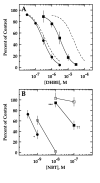Determinants of competitive antagonist sensitivity on neuronal nicotinic receptor beta subunits
- PMID: 8656274
- PMCID: PMC6578601
- DOI: 10.1523/JNEUROSCI.16-12-03798.1996
Determinants of competitive antagonist sensitivity on neuronal nicotinic receptor beta subunits
Abstract
We constructed a series of chimeric and mutant neuronal nicotinic acetylcholine receptor beta subunits to map amino acid residues that determine sensitivity to competitive antagonists. The beta 2 and beta 4 subunits form pharmacologically distinct receptors when expressed in combination with the alpha 3 subunit in Xenopus oocytes. At equipotent acetylcholine concentrations, alpha 3 beta 2 is 56-fold more sensitive to blockage by dihydro-beta-erythroidine than is alpha 3 beta 4. The alpha 3 beta 2 combination is also sensitive to long-term blockade by neuronal bungarotoxin, whereas alpha 3 beta 4 is not. Pharmacological analysis of receptors formed by chimeric beta subunits reveals that amino acid residues that determine both dihydro-beta-erythroidine and neuronal bungarotoxin sensitivity are located within several sequence segments. The major determinant of sensitivity to both competitive antagonists is located between residues 54 and 63. A minor determinant of sensitivity to both antagonists lies between residues 1 and 54, whereas a minor determinant of NBT sensitivity lies between residues 74 and 80. Within region 54-63 of beta 2, mutant beta 2 subunits were used to identify threonine 59 as a residue critical in determining competitive antagonist sensitivity. Changing threonine 59 to lysine, as occurs in beta 4, causes a 9-fold decrease in dihydro-beta-erythroidine sensitivity and a 71-fold decrease in neuronal bungarotoxin sensitivity. Changing polar threonine 59 to negatively charged aspartate causes a 2.5-fold increase in neuronal bungarotoxin sensitivity and has no effect on dihydro-beta-erythroidine sensitivity.
Figures





Similar articles
-
Multiple determinants of dihydro-beta-erythroidine sensitivity on rat neuronal nicotinic receptor alpha subunits.J Neurochem. 1996 Nov;67(5):1953-9. doi: 10.1046/j.1471-4159.1996.67051953.x. J Neurochem. 1996. PMID: 8863500
-
Mapping of ligand binding sites of neuronal nicotinic acetylcholine receptors using chimeric alpha subunits.Mol Pharmacol. 1993 Sep;44(3):657-66. Mol Pharmacol. 1993. PMID: 8371718
-
Glycosylation within the cysteine loop and six residues near conserved Cys192/Cys193 are determinants of neuronal bungarotoxin sensitivity on the neuronal nicotinic receptor alpha3 subunit.Mol Pharmacol. 1998 Jun;53(6):1112-9. Mol Pharmacol. 1998. PMID: 9614216
-
Agonist and antagonist effects of nicotine on chick neuronal nicotinic receptors are defined by alpha and beta subunits.J Neurophysiol. 1994 Sep;72(3):1317-26. doi: 10.1152/jn.1994.72.3.1317. J Neurophysiol. 1994. PMID: 7807214
-
Localization of agonist and competitive antagonist binding sites on nicotinic acetylcholine receptors.Neurochem Int. 2000 Jun;36(7):595-645. doi: 10.1016/s0197-0186(99)00154-0. Neurochem Int. 2000. PMID: 10771117 Review.
Cited by
-
What We Have Gained from Ibogaine: α3β4 Nicotinic Acetylcholine Receptor Inhibitors as Treatments for Substance Use Disorders.J Med Chem. 2023 Jan 12;66(1):107-121. doi: 10.1021/acs.jmedchem.2c01562. Epub 2022 Nov 28. J Med Chem. 2023. PMID: 36440853 Free PMC article. Review.
-
Patterns of nicotinic receptor antagonism II: cardiovascular effects in rats.Drug Alcohol Depend. 2013 Aug 1;131(3):284-97. doi: 10.1016/j.drugalcdep.2012.12.021. Epub 2013 Jan 18. Drug Alcohol Depend. 2013. PMID: 23333294 Free PMC article.
-
Molecular determinants of subtype-selective efficacies of cytisine and the novel compound NS3861 at heteromeric nicotinic acetylcholine receptors.J Biol Chem. 2013 Jan 25;288(4):2559-70. doi: 10.1074/jbc.M112.436337. Epub 2012 Dec 10. J Biol Chem. 2013. PMID: 23229547 Free PMC article.
-
Cell-Specific Cholinergic Modulation of Excitability of Layer 5B Principal Neurons in Mouse Auditory Cortex.J Neurosci. 2016 Aug 10;36(32):8487-99. doi: 10.1523/JNEUROSCI.0780-16.2016. J Neurosci. 2016. PMID: 27511019 Free PMC article.
-
Introduction of unsaturation into the N-n-alkyl chain of the nicotinic receptor antagonists, NONI and NDNI: effect on affinity and selectivity.AAPS J. 2005 Aug 29;7(1):E201-17. doi: 10.1208/aapsj070119. AAPS J. 2005. PMID: 16146341 Free PMC article.
References
-
- Abramson SN, Li Y, Culver P, Taylor P. An analog of lophotoxin reacts covalently with Tyr190 in the α-subunit of the nicotinic acetylcholine receptor. J Biol Chem. 1989;264:12666–12672. - PubMed
-
- Bertrand D, Bertrand S, Ballivet M. Pharmacological properties of the homomeric α7 receptor. Neurosci Lett. 1992;146:87–90. - PubMed
-
- Blount P, Merlie J. Molecular basis of the two nonequivalent ligand binding sites of the muscle nicotinic acetylcholine receptor. Neuron. 1989;3:349–357. - PubMed
-
- Cohen JB, Blanton MP, Chiara DC, Sharp SD, White BH. Structural organization of functional domains of the nicotinic acetylcholine receptor. J Cell Biochem [Suppl] 1992;16E:217.
Publication types
MeSH terms
Substances
Grants and funding
LinkOut - more resources
Full Text Sources
